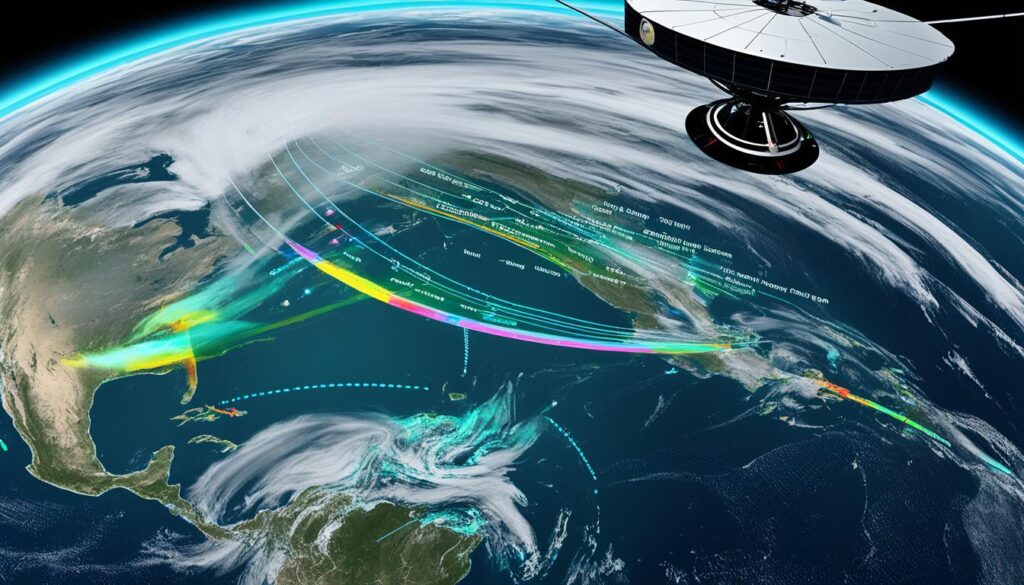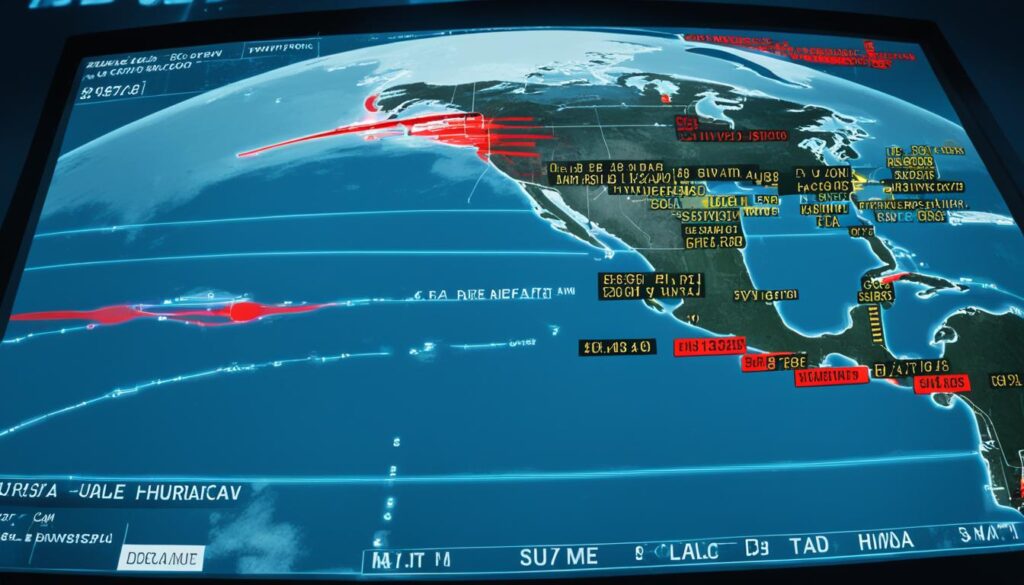Track Hurricanes in Real-Time: Hurricane Tracker
The Hurricane Tracker gives live updates and weather details through an IFrame. This tool lets people watch storms as they happen. It helps them make smart choices about staying safe.
This app has cool features like viewing everything in a big window. It’s perfect for keeping an eye on storms, especially in busy hurricane seasons predicted by NOAA for 20241.
Key Takeaways
- Real-time hurricane tracker offers live updates on current weather systems.
- Live weather updates help in making timely and informed safety decisions.
- Advanced storm monitoring capabilities for immersive and accurate tracking.
- Full-window viewing option enables comprehensive monitoring of hurricanes.
- Critical during above-normal Atlantic hurricane seasons1.
Introduction to Real-Time Hurricane Tracking
Tracking hurricanes in real-time is new and important. It uses the latest technology to watch storms grow. This helps us understand hurricanes better, forecast weather, and keep people safe.
A key part of watching tropical storms is the real-time system. It keeps an eye on storms in different areas. It tells us details like the storm’s name, where it is, its strength, and which way it’s moving2.
The National Hurricane Center (NHC), in Miami, FL, forecasts for the North Atlantic and east North Pacific. The Central Pacific Hurricane Center (CPHC), in Honolulu, HI, does this for the Central North Pacific3. The Joint Typhoon Warning Center (JTWC), in Pearl Harbor, HI, looks after the forecasts for the western North Pacific and south of the equator3.
There are many types of storms like tropical waves, storms, and hurricanes. This real-time system helps us track them better. It makes weather forecasts more exact2.
Knowing about wind guidance is also key to making better forecasts. Charts that show possible wind speeds help a lot. They make our predictions better and keep everyone safer2.
After a storm season, U.S. agencies share the best information. This is after carefully checking the storm’s history. Doing this helps us get better at watching and predicting storms2.
How Hurricane Trackers Work
Hurricane trackers work with a smart system for live tracking and to predict storms. They use satellites, radars, and smart models to check the weather.
Satellite Imagery
Satellites help see big weather patterns. The GOES-R system gives a close eye from start to end of hurricanes. Since the 1950s, forecasters with satellites have more info to predict storms.

Radar Systems
Radar helps see rain and wind up close. Ground-based radars give important data when a storm is about 450km from land4. They work with sensors to watch flooding and other dangers5.
Data Analysis and Models
Using data and models is key to predict where hurricanes will go and how bad they might be. Water temperature, wind, and saltiness help decide the hurricane’s path and strength5. Tools like GIS maps help with this and also help plan evacuations and check on damage6. The NHC makes sure everyone is ready by sharing its forecasts4.
Benefits of Using a Hurricane Tracker
A hurricane tracker helps us stay ready and safe. It makes emergency plans better and keeps the coast safer.
Early Warning Systems
Hurricane trackers give quick alerts before a storm hits. The GOES-R Series satellites check areas every 30 seconds7. This lets us prepare and evacuate in time. First responders use this info to decide where help is needed most during floods7. When Hurricane Ian came, this tech helped agencies plan relief efforts quickly8.
Accurate Weather Forecasting
Knowing the weather well helps us plan and manage risks better. The ABI on GOES-R Series satellites makes weather predictions very detailed7. It lets experts see storm patterns and guess how strong hurricanes will be. Plus, the Geostationary Lightning Mapper watches lightning to predict if hurricanes will get stronger up to a day ahead7.
Forecasters mix data from satellites, sensors on land, and weather balloons to guess storm power9. This all makes the coast safer. It means people get warnings early. That’s very important in reducing hurricane harm.
Best Hurricane Tracker Tools and Apps
In today’s changing world, being on top of hurricanes is key. The best apps use top-notch tech to keep you updated. They make sure you’re ready for anything.
One app stands out, with a 4.9 rating from 6.23K reviews. It gives you maps, NOAA forecasts, model predictions, and ways to stay safe10. People love how easy it is to use and how fast they find what they need10. Plus, it sends alerts and is easy to navigate with your fingers10.

Another good app has over 100 tools and 15 GOES Satellite filters11. With a Pro Subscription, you get top-quality images and long-range forecasts11. It’s known for being spot-on and dependable by its users11.
A different app, updated to version 4.8.6 on June 20, 2024, pulls in a lot of info. You can look up storms from as far back as 1851 in the Atlantic and 1949 in the Pacific12. Even with a few hiccups in alerts, it’s praised for its simple design and really useful details12.
| Features | App 1 | App 2 | App 3 |
|---|---|---|---|
| Rating | 4.9 out of 5 (6.23K reviews)10 | Positive reviews for accuracy and reliability11 | Positive reviews highlighting ease of use12 |
| Notable Features | NOAA forecasts, ensemble models, safety & preparedness info10 | High-resolution satellite imagery, 35-day probability of formation data11 | Access to historical data from 1851 (Atlantic) and 1949 (Pacific)12 |
| Subscription | N/A | Pro Subscription with exclusive features11 | N/A |
Current Active Storms and Real-Time Data
With active cyclones globally, following storms is key for quick and correct info. Updated storm data keeps us safe and ready in affected areas.
Atlantic Storms
The Atlantic hurricane season starts June 1st and ends November 30th. This time, tracking storms is really important13. We watch closely when winds are from 39-73 mph, known as Tropical Storms13. For storms over 74 mph, called Hurricanes, we look at how strong they are and what danger they might bring13. We use real-time data to watch storms like Tropical Storm Alberto. It tells us where they are, how strong, and where they’re heading.
Pacific Storms
Storms in the Pacific need good tracking for fast and right alerts. Live data and satellite views watch these storms all the time. Tropical Cyclone Public Advisories give important info like watches and warnings, wind speeds, movement, and storm dangers14. This info helps us make good choices and get ready in places that might be hit.
Indian Ocean Storms
In the Indian Ocean, we keep an eye on big storms like REMAL as they happen. We issue Storm Surge Warnings 36 hours before they could hit, warning about dangerous flooding. When conditions are right, Tropical Storm Warnings are sent out for winds from 39-73 mph14. Keeping up with live storm data is really important. It gives us info right away about the storm’s path and how it’s growing.
| Storm Category | Max Sustained Winds | Warning Issued |
|---|---|---|
| Tropical Depression | 38 mph or less | Tropical Weather Outlook |
| Tropical Storm | 39-73 mph | Tropical Storm Warning |
| Hurricane | 74 mph or higher | Hurricane Warning |
Emergency Preparedness and Safety Tips
Hurricanes can be dangerous. It’s important to get ready, like making evacuation plans and emergency kits. Doing this helps lower the damage and makes it easier to be rescued or recover.
Evacuation Plans
Being ready to leave is key. Make a plan that fits with local warnings. Use Hurricane Watches and Warnings, which come 48 to 36 hours before. They help you get ready for dangers ahead15. Listen to alerts and follow when to leave to stay safe16. Unless told to go, stay off the roads to keep everyone safe16. Pick a meeting spot if you get lost from your family to make everyone find each other later17 .
Emergency Kits
Building an emergency kit is very important. Put in food, water, and medicine that won’t go bad16. Use flashlights with batteries during blackouts, not candles, to avoid fires15. Also, add extra batteries, a first-aid kit, and hygiene stuff to be even more prepared16. Don’t forget about flood insurance, because normal home insurance doesn’t cover floods17.

Hurricane Path Predictions and Forecasting
Forecasting hurricanes has gotten a lot better thanks to new tech and careful weather study. The National Hurricane Center (NHC) doesn’t always get it right. About 60% to 70% of the time, they correctly predict the path within 5 days18. Satellites, radars, and computer models help figure out where a storm will go. They give us info on how strong the storm is and where it might hit land.
From 2023 to 2025, special gliders help us know more about hurricanes19. They make storm predictions more exact. This is key for planning how to keep people safe during a storm. The NHC gives info on where storms might go and how strong they could get19. Graphs show how sure we are about the predictions for days 1 to 518.
Tropical Storm Beryl in the Atlantic might become a major hurricane by Monday20. Some computer models think it could hit major strength before the Caribbean20. Groups like NOAA and SECOORA give live updates on storm risks and what to expect19.
The University of South Florida helps us follow storms near the West Florida Shelf in real time19. Tools like the USGS Flood Event Viewer and the Advanced Surge Guidance System also help. They show where storm surges may happen, supporting emergency plans19.
Good weather analysis lets experts warn about storms like Beryl. It might bring heavy rain and dangers to places like Barbados20. By improving how we forecast hurricanes, we can be better ready and keep everyone safer.
Impact of Climate Change on Hurricane Activity
Researchers find a big link between global warming and more intense hurricanes. From 1979 to 2017, there were more major hurricanes but fewer small ones21. This change shows how warmer sea temperatures lead to stronger storms and different hurricane patterns22.

The NOAA expects more Category 4 and 5 hurricanes with stronger winds because of warmer seas21. In a 2-degree Celsius warming, cyclone strength could rise 1 to 10%23. This suggests that global warming plays a big role in hurricane power.
Warmer seas also make hurricanes rain more, possibly 10-15% more21. This more rain is backed up by studies, showing up to a 15% increase in rainfall within 100 km of a storm23. Considering human activities since 1971 have helped raise sea levels, this extra rain is a significant concern.
Hurricanes now move more slowly, so they cause damage over longer periods21. This causes issues like increased flooding and more damage to homes and infrastructure. With more people living on the coast since the 1970s, the risks from these hurricanes have grown a lot21.
Experts warn that as the earth gets warmer, hurricanes could become more intense in the Atlantic22. While there isn’t strong data showing more U.S. hurricanes, the danger to health and homes is a real concern23. Understanding the link between global warming and hurricanes is more important than ever.
The Science Behind Tropical Cyclones
Exploring tropical cyclones teaches us how they start and are sorted, key for predicting and staying safe.
Formation of Hurricanes
Tropical cyclones grow over warm sea areas. Here, heat mixes with moisture to form these mighty storms. Ever since the 1960s, weather satellites have greatly boosted how quick we can spot and follow them. This use of advanced technology, like satellites and planes that fly into hurricanes, helps experts at the National Hurricane Center know where storms are and how strong they’re becoming. This blend of info is crucial for getting the weather warnings right and making sure people are ready for the storms24.
Categories of Hurricanes
When a tropical cyclone shapes, it’s rated by its wind’s power. The Saffir-Simpson scale divides hurricanes into five groups, showing their potential harm. Better tools, like the CyMISS project, aim to offer very detailed data for the stronger storms25. Also, through the work of groups like ATCF, predicting how strong a hurricane will get is more exact. This helps warn people in a storm’s path early and accurately, boosting safety decisions26.
Conclusion
Hurricane trackers are super important in keeping us safe from dangerous storms. They use satellite pictures, radar, and computer models to watch hurricanes. With these tools, we can predict where a hurricane will go and how strong it will be. This helps towns and cities get ready for the storm before it hits.
NOAA says the Atlantic hurricane season in 2024 could be really active. This makes it very important to stay updated with the latest from the National Hurricane Center (NHC)2728. For example, Tropical Storm Beryl might turn into a big, dangerous hurricane before it reaches the islands27. So, it’s crucial for everyone to be ready and keep an eye on the news.
New technology is making hurricane tracking even better. Things like flying into the storms to get more info, adding nice pictures on maps, and forecasting how fast the winds are improving. This detailed info helps keep us safe and lets us prepare better when a hurricane is on the way.
FAQ
What is a real-time hurricane tracker and how does it work?
Why is it important to have a hurricane tracker?
How do satellite imagery and radar systems help in storm tracking?
What are the benefits of using hurricane tracker tools and apps?
What kind of information can I get from a hurricane tracker about active storms?
How do early warning systems enhance coastal safety?
In what ways can climate change impact hurricane activity?
How are hurricanes categorized and what scales are used?
What should be included in an emergency kit for hurricane preparedness?
How does advanced data analysis contribute to hurricane forecasting?
Table of Contents
Source Links
- National Hurricane Center – https://www.nhc.noaa.gov/
- RAL | Tropical Cyclone Guidance Project – https://hurricanes.ral.ucar.edu/realtime/
- RAMMB: TC Real-Time: Descriptions of Products – https://rammb-data.cira.colostate.edu/tc_realtime/about.asp
- National Hurricane Center Forecast Process – https://hurricanescience.org/science/forecast/forecasting/forecastprocess/index.html
- Hurricane Tracking Technology: Advancements and Opportunities – IEEE Public Safety Technology Initiative – https://publicsafety.ieee.org/topics/hurricane-tracking-technology-advancements-and-opportunities
- How to Track a Hurricane: GIS and Storm Tracking | UT Permian Basin Online – https://online.utpb.edu/about-us/articles/gis-geospatial/how-to-track-a-hurricane-gis-and-storm-tracking
- GOES-R hurricane monitoring fact sheet – https://www.goes-r.gov/education/docs/fs_hurricane.pdf
- Tracking Hurricane Ian: The Benefits of Remote Sensing and SAR – https://www.iceye.com/blog/tracking-hurricane-ian-remote-sensing-sar
- Hurricane Prediction Technology – IEEE Public Safety Technology Initiative – https://publicsafety.ieee.org/topics/hurricane-prediction-technology
- Tropical Hurricane Tracker – Apps on Google Play – https://play.google.com/store/apps/details?id=com.jpltech.hurricanetracker&hl=en_US
- National Hurricane Center Data – https://apps.apple.com/us/app/national-hurricane-center-data/id1289108781
- My Hurricane Tracker & Alerts – https://apps.apple.com/us/app/my-hurricane-tracker-alerts/id1020486515
- 2024 Hurricane Season – Track The Tropics – https://www.trackthetropics.com/
- Live Current and Future Winds « 2024 Hurricane Season – Track The Tropics – https://www.trackthetropics.com/live-winds/
- VA.gov | Veterans Affairs – https://www.visn8.va.gov/emergency_preparedness.asp
- Hurricane Safety Tips – https://www.thehartford.com/claims/hurricane-preparedness
- Hurricane Preparedness – https://www.weather.gov/mhx/hurricaneprep
- TROPICAL STORM BERYL – https://www.nhc.noaa.gov/graphics_at2.shtml?cone
- Hurricane Resources – SECOORA – https://secoora.org/hurricane-resources/
- Tropical Storm Beryl forms in Atlantic, could be hurricane by Saturday night – https://www.usatoday.com/story/news/weather/2024/06/28/tropical-depression-could-become-hurricane-beryl/74244289007/
- Hurricanes and Climate Change – https://www.c2es.org/content/hurricanes-and-climate-change/
- National Climate Assessment – https://nca2014.globalchange.gov/report/our-changing-climate/changes-hurricanes
- Global Warming and Hurricanes – Geophysical Fluid Dynamics Laboratory – https://www.gfdl.noaa.gov/global-warming-and-hurricanes/
- Tropical cyclone – Tracking, Forecasting, Impacts – https://www.britannica.com/science/tropical-cyclone/Tracking-and-forecasting
- Tracking Hurricanes and Typhoons from Space – https://www.issnationallab.org/tropical-cyclone-in-sight-tracking-hurricanes-typhoons-from-space/
- Technology & Science Branch – https://www.nhc.noaa.gov/abouttsb.shtml
- National Hurricane Center – https://www.nhc.noaa.gov/?cpac
- Hurricane Tracker 101: Monitoring Current Storms Simplified | Insurance Claim Recovery Support-Public Insurance Adjusters – https://www.insuranceclaimrecoverysupport.com/hurricane-tracker/







Average Rating